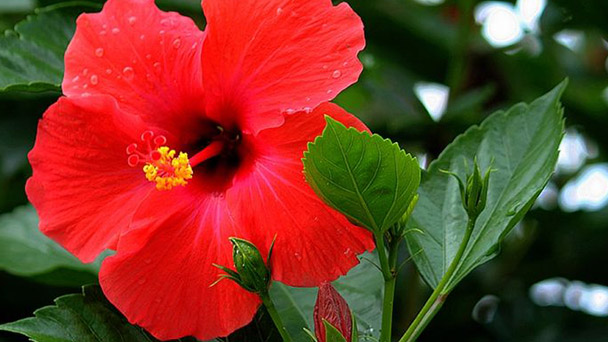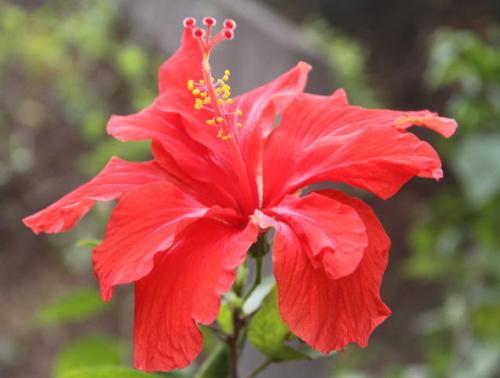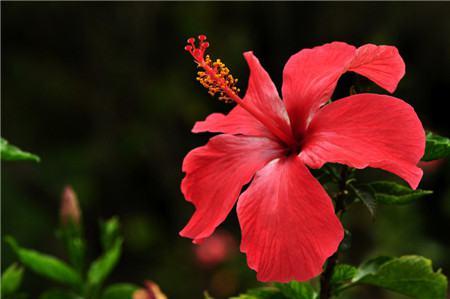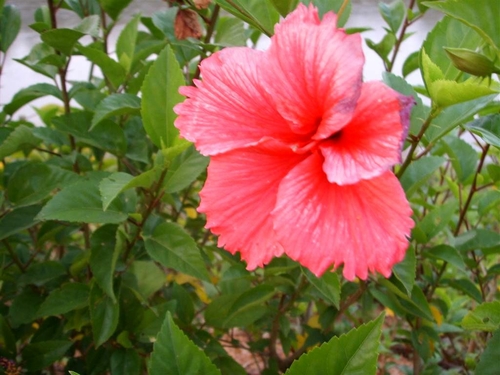Hibiscus rosa-sinensis breeding methods and matters needing attention
Written by Maggie
Nov 13 2020

Hibiscus rosa-sinensis is currently more common in the Yangtze River valley in my country, and it is less common in other places because it is not easy to survive. So how is Hibiscus rosa-sinensis cultured correctly? What are the good methods in breeding? What should be paid attention to when breeding Hibiscus rosa-sinensis? Please read it down with me with your questions!
Hibiscus rosa-sinensis picture

Hibiscus rosa-sinensis breeding method
The best breeding time: Hibiscus rosa-sinensis cutting propagation in May to October, grafting propagation in spring and autumn.
Best growing soil: Hibiscus rosa-sinensis can adapt to various soils, but the fertile, loose, slightly acidic soil is best.
Growing humidity requirements: Hibiscus rosa-sinensis often sprinkle water on the ground to increase humidity and reduce temperature, and prevent young leaves from scorching and flowers from falling early.
Optimal growth temperature: Hibiscus rosa-sinensis grows at a temperature of 15~25℃, and it is 13~18℃ from October to March of the following year.
Optimal growth light: Hibiscus rosa-sinensis is a strong positive plant, and sufficient light is required during the growth period to grow and bloom normally. If the light is insufficient, the flower buds are easy to fall off, the flowers are small, and the flower color is dim; but when the sun is too strong, the plants will burn, so they should be properly shaded.
Precautions for breeding Hibiscus rosa-sinensis:
Application of fertilizer: Hibiscus rosa-sinensis is the growing season of hibiscus in early May. It is necessary to strengthen the management of fertilizer and water, and apply thin liquid fertilizer every 7 to 10 days.
Watering points: Hibiscus rosa-sinensis should be watered adequately during the growth period, without lack of water, nor flooded. It is usually watered once a day, and once in the morning and once in the evening.
Pruning essentials: Hibiscus rosa-sinensis needs to be pruned during cultivation, which not only enhances the ornamental value of its shape, but also avoids the occurrence of various pests and diseases. When pruning, you can cut off all branches except for 2 to 3 buds at the base. After pruning, water and fertilizer should be properly controlled.
Pot soil replacement: When Hibiscus rosa-sinensis changes pots, there are three things to do: one is to replace it with a new culture soil; the other is to cut off part of the densely curled fibrous roots; the third is to apply sufficient basal fertilizer and a little phosphate fertilizer on the bottom of the pot. In order to maintain a beautiful tree shape and a large amount of flowers, according to Hibiscus rosa-sinensis's strong sprouting ability, pruning and shaping can be carried out before and after leaving the house in early spring. All branches are cut except for 2 to 3 buds at the base. , Pruning can promote the development of new branches, the growth will be more vigorous, and the plant shape is also beautiful. After pruning, due to the reduced consumption of the ground part, water and fertilizer should be appropriately controlled.

Breeding points: Hibiscus rosa-sinensis is reproduced by cutting or grafting.
1. Cuttings. It is carried out from May to October and in the greenhouse in winter, but the survival rate is high during the rainy season. The cuttings are the best one year-old and semi-ligninized. The length is 10 cm. The lower leaves are cut off, and the top leaves are kept. The cut should be flat, inserted in the sand bed, and maintain high air humidity. The room temperature is 18-21 ℃, and 20~ after insertion. Take root in 25 days. Treating the base of the cuttings with 0.3{bf}~0.4{bf} indole butyric acid for 1-2 seconds can shorten the rooting period. Transplant into pots when the roots are 3 to 4 cm long.
2. Grafting. It takes place in spring and autumn. It is mostly used for hibiscus varieties with difficult cuttings or slow rooting, especially double-petal varieties with low cutting survival rate. It can be grafted or bud grafted, and the rootstock uses single flower hibiscus. The grafted seedlings blossomed that year.
Pest control: Hibiscus rosa-sinensis has the following diseases and control methods.
1. Leaf spot disease. The key to the prevention and control of this disease is to do a good job of preventing the cold, and take protective measures against Hibiscus rosa-sinensis when the temperature is lowered by strong winds after autumn. On this basis, spray 500-800 times liquid zinc or 1500 times {bf} ammonium in time. Play a very good control effect.
2. Stem rot. The key to the prevention and control of this disease is to prevent long-term heavy rain from scouring Hibiscus rosa-sinensis plants, and apply 200-500 times solution of thiophanate to dryness every 10 days before and after the rainy season. Tests show that this method has a good control effect.
3. Root knot nematode disease. The prevention and treatment of this disease is difficult. If the number of plants is small, the soil can be replaced, the soil must be exposed to the sun for a long time, and the old soil should not be used. Aldicarb granules can also be applied to more Hibiscus rosa-sinensis plants, and it can be planned to bury about 0.5 g in a 5-inch pot.

Hibiscus rosa-sinensis experience:
1. Hibiscus rosa-sinensis is not tolerant to frost. It must be moved indoors to keep warm after the frost and before the beginning of winter. The overwintering temperature is required to be no lower than 5°C to avoid freezing damage; no higher than 15°C to avoid affecting dormancy. Poor dormancy and poor growth and flowering the following year.
2. Potted Hibiscus rosa-sinensis, usually leaves the house in April, change the pot before leaving the house, and properly trim it to maintain a beautiful crown.
Latest Updated
- Benefits of Bugleweed - 7 Science-backed Health Benefits
- Bugleweed Dangers & Side Effects - Is It Poisonous?
- How to Plant Evergreen Trees - What You Should Know
- When to Plant Evergreens - Grow Guide for Evergreen Trees
- 12 Wonderful Evergreen Shrubs for Your Garden
- 12 Popular Evergreen Plants with Pictures for Beginners
- When And How To Prune A Lilac Bush Like a Pro
- How to Grow & Care for Lilac Vine (Hardenbergia Violacea)
- Japanese Lilac Tree (Syringa Reticulata) Care & Propagation Guide
- Shumard Oak Pros and Cons - What to Know
Popular Articles
- Winter maintenance of Antirrhinum Majus
- How to Grow Terminalia Mantaly Tree
- How to Grow and Care for Crossostephium Chinense
- How to grow Antirrhinum Majus in spring
- Peristeria Elata (Dove Orchid) Profile: Info & Care Guide
- Underwatered Snake Plant (Sansevieria Trifasciata) - Signs And How To Fix
- How to Care for Brazilian Jasmine Plant (Mandevilla Sanderi)
- How to Grow & Care for Graptopetalum Purple Delight in Summer
- Rosa Chinensis (China Rose): Plant Growing & Care Tips
- How to Care for Baby Sun Rose (Aptenia Cordifolia)